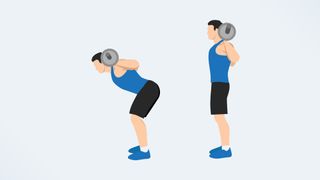I did 30 Good Mornings every day for a week — here’s what happened to my body
It’s a simple move with a silly name, but it sure hits the spot

A Good Morning exercise sounds easy: get out of bed, scratch yourself discreetly (or not) in a few places while yawning, and, maybe, stretch. But, of course, it is not that. Not at all. It is, instead, a deeply satisfying and effective exercise, and one that caught me by surprise. In a great way.
What is a Good Morning?
Let’s deal with the name first. Some say it’s so called because it resembles the movement your make as you get out of bed. Not the way I get out of bed, I assure you. Others maintain it’s a holdover from Victorian times, when gentlemen were expected to bow to ladies. I’ve watched a lot of period dramas and no one bends that far to say ‘Hi!’.
Still others say it is named for the bow with which some children begin the school day in Japan. None of this can be verified, but the exercise has been around for a century and, let me tell you, it works. Since it is usually done with a barbell (at least in gyms), it is sometimes called a Barbell Good Morning, but where’s the mystery in that?
What does it do?
For a simple-looking hip-hinge exercise, the Good Morning hits a lot of big muscles: hamstrings, glutes and — the effect on these really surprised me — the erector spinae muscles, which lie on either side of the backbone and run from the base of your skull to your hips. These large muscles straighten the back and help with rotation. The Good Morning also works your transverse abdominals, which support the torso and help protect your internal organs.
How do you do a Good Morning?
Hinge forward at the hips: elementary, right? And that’s why it’s so easy to do it incorrectly. As noted, it’s generally done with a barbell (with or without weights) in gyms, but who keeps one of those around the house? Dumbbells are just as good (grab a pair of adjustable dumbbells here). You can hold one small weight on each shoulder or use both hands to hold one heavier weight close to the top of your chest. I used one 4g dumbbell, but you should choose a weight with which you are comfortable.

Begin in a standing position, feet hip-width apart, dumbbell(s) raised where you prefer. You should have a slight, loose bend in the knee. From here, engage your glutes and hinge forward at the hips. Keep your back flat as your bend forward and do not increase the bend in your knees. Hinge until your back is parallel with the floor, if you can (do not attempt to force things or to bend your back). Keep your head in line with your flat spine. Come back up to standing, pushing your hips forward, to complete one rep. Start with three sets of 10 and see how you feel. Of course, if you have a history of back problems, please seek advice from a medical professional before you do this exercise.
I did 30 Good Mornings every day for a week — here’s what happened
One day one, I tried the move with two smaller dumbbells, holding one on each shoulder, but I was never comfortable. That said, mine are a pair of slightly awkward adjustable dumbbells. I was not surprised to feel the move in my hamstrings, but I was a little alarmed by how tight and unyielding they were. For the rest of the day I was keenly aware I had worked them that morning.
Sign up to get the BEST of Tom's Guide direct to your inbox.
Get instant access to breaking news, the hottest reviews, great deals and helpful tips.
But what truly amazed me was the stretch I noticed afterwards in my erector spinae muscles. They felt as if a juiced-up sports masseur having a bad day had been in there will all his knuckles. You know that good hurt you feel after, say, a yoga session you’ve put off for three months? That.
One day two, I changed to one dumbbell and found this far more to my liking. I was feeling the strain in my hamstrings from day one, but decided this was a good thing, as I had no choice. I was slightly breathless by the time I hit 30 without a break, but this is not a move that requires balancing skills (read what happened when I did glute bridges for a week here), or resting your weight on a forearm, (like my week of side planks) so I still found it easier to maintain form than I had in some other week-long challenges.
Worried by my overconfidence I did day three standing by a full-length mirror. Sure enough, there was a slight bend in my spine at the end of the hinge, so I corrected that. I was still feeling it in my hamstrings and erector spinae muscles, but by this stage, it was my hamstring tendons that were letting me know something was happening that did not meet with their approval. I felt they’d have hit a high E note if I plucked them.
On day four, I decided to try something. I can usually touch my toes with no problem. Not today. I felt a deep reluctance in my hamstrings. Not that they were tight — no, they were sore. Which is why day five knocked me for a loop.
If you’ve ever struggled to master something new, you always relish that great day when you can suddenly just do it and from then on, you wonder how you ever couldn’t do it. That was me with Good Mornings on day five. I did them with ease — 35, in fact — and I felt no pull, no strain, and no tightness in my hamstrings for the rest of the week, or thereafter. The feeling of stretch in my erector spinae was wonderful. I felt looser, smoother, and stronger. I now looked forward to doing this move each morning. On day six I did 35 again and hit 40 on day seven. I have been evangelizing ever since.
Of all the moves I have done for Tom’s Guide so far, this is the one I know I will return to most often. It will aid my running, by strengthening and stretching my hamstrings and working my glutes, but it is the effect on my back muscles that is most noticeable. They seem longer, somehow, and I feel great. It’s Good Morning from me from now on, every single day.
Next: I just tried Chris Hemsworth’s 70-rep bodyweight workout — here’s what happened
John is a writer and editor based in London. He was worked for magazines such as Runner’s World, Men’s Health, Women’s Health and Cosmopolitan. A keen runner, what he lacks in ability he makes up for with enthusiasm and excuses.
